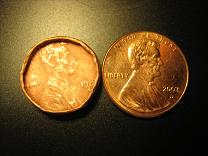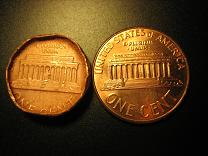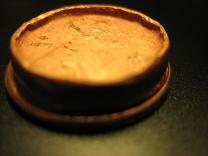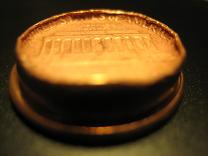January 20, 2008
Fun with Copper
Lately I have been interested in copper. Not quite sure why, but a few clues have been apparent. First, I am on my way towards trying to create a useful a home-made Printed Circuit Board [PCB] (more later). This involves using an etched copped board for the conductivity between parts that are soldered onto the board. Secondly, I remember very oxidized roofs of capitol buildings which were made from copper. Thirdly, I remember reading about copper being in a bull market due to construction (which may have reversed course these days due to worldwide property bubbles). And Lastly, a little unrelated, but the web site I saw about making a ring from a 1964 and prior half-dollar or quarter: Link!
Based on the last point and general curiosity, I hammered down a copper penny. This had no intentions along the ring design nor any relation to electronical conductivity. It was more of a fill some weekend time and expand my thinking. More info and photos at the next link!
Based on the ring making kit, I decided to donate some hours to hammering down a copper penny. Since these days the government doesn't want to give away free money, they are just taking a zinc slug and plating with a dip of copper, I used a 1981 coin with a higher copper concentration in the mix. You can find more exhaustive info about that in various wiki. Additionally, you can see directly why they stopped using that mix via coinflation: Link
So, I spent time hammering down this mostly copper penny from 1981 and took some photos to show it in relation to its bastardized brother post 1981, AKA the modern cent. These are thumbnails, but are clickable to view the full versions. This hammering procedure took place between hammer to coin held in wooden chopsticks to thin magazine to my right thigh. I spare you the picts of my bruised up leg in the below series. However, I do want to shrink this more and will sacrafice the left leg in doing so. I didn't give a try to the ring creation guy's hammer from concrete flooring, covered by steel plate, and holding of coin with fingers. My fingers are much too large to hold a penny without stray hammer strikes landing directly on the flesh and causing great shock to the phalanges of the hand, which I happen to find quite useful.
Below are the results on first day. I had to run out for errands and had a sore leg, so it happened to be a great matching in schedule.
Further note, the 1981 coin was very brown due to heavy oxidation, so I did try to brighten the day with a salt and vinegar solution (recommend web searching for that). As you can see in the high resolution photos, it did alter the sharpness an clarity of both sides.
In the high resolution photos, you may see the In God We Trust in the Observe Reeding. On the Reverse Reeding, you can see the start of United States of America being pushed vertical. Well that is all, not much useful stuff here, but I did learn Copper is a great conductor. It is used on etching PCB for creating home made circuits. Additionally, it oxidizes and that's the reason for green or brown discolorations. Also, that oxidation is pretty deep since, as you can see in these photos, most of the detail of the good ole Abe is lost after soaking in a NaCl and 5% acetone mixture then washing in H20, polishing with a damp H2O cloth and finally drying.
Final learning situation was that I happen to be corny and enjoy those flattened penny machines that imprint your current landmark. I noticed some silver streaks and rapid decomposition in the recent one we made in Julian, CA this past summer. Rather than use a modern penny, I will be carrying some 1981 and prior with me for use with those machines. this should give a more consistent look and feel as it presses mostly copper through the flattening. With the modern penny, it is a copper plating and the underneath zinc bleeds through.
Comments
I will sell you my 1981 and prior pennies for double the minted price.



